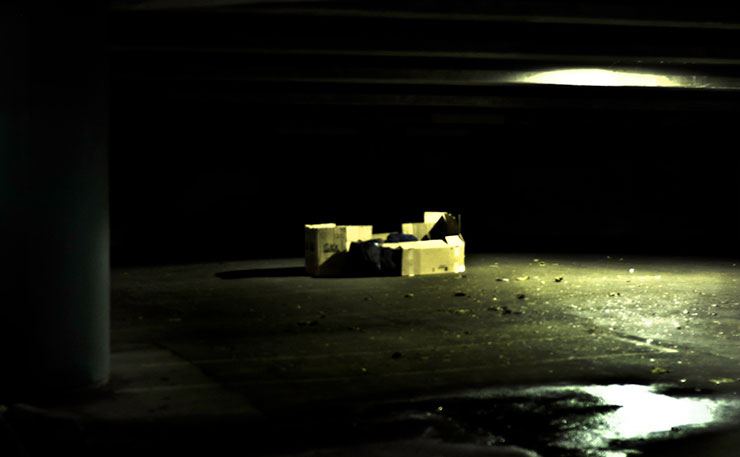Once upon a time, Australia had a social welfare system designed to lift up the poor. Now we have a system designed to punish them. Sharna de Lacy from StreetSmart explains.
The plan to redefine ‘camping’ to criminalise rough sleeping was recently dumped by the Melbourne City Council amid well-founded fears of a lengthy legal battle. Instead, the Council opted for tougher policing of begging – moving people out of the way, and then through the court system.
It comes just one month after the NSW government’s successful shutdown of the so-called ‘tent city’ on the Reserve Bank’s doorstep in Sydney. By giving authorities the power to remove people or goods who are deemed to have an “unacceptable impact on the public.” Most elected to leave before they were forcibly evicted.
While the encampments in Sydney and Melbourne CBD have given a visibility to homelessness, and to the heavy-handed instincts of public institutions towards the poor, this is the tip of a much greater iceberg.
A recent report by the Council for Homeless Persons found that 37% of rough sleepers are in the middle and outer suburbs, whereas only 8% of people sleeping rough gravitate to inner metro areas.
“Rough sleeping in the CBD and central areas has a lot of visibility and media coverage, but there are a lot of rough sleepers in the outer suburbs,” says Jay Church from Anchor’s Housing and Support Services, an organisation servicing Melbourne’s Yarra Ranges.
The Yarra Ranges includes the very outer urban fringe and semi-rural areas. The region ranks highly in all the wrong categories. Housing stress is estimated to sit at 30.3%, and ranks in the top 10 areas for socio-economic disadvantaged communities nationally.
“The Yarra includes pockets of deep poverty, and a highly vulnerable demographic,” Church said. “Coupled with the cost of private rental, the capacity to meet that cost is simply out of reach for lots of people.”
Suburban homelessness is increasing in tandem with the out-of-control housing market, divestment in social housing, stagnant wage growth and the casualisation of the labour force. It’s a perfect storm, and those least equipped to weather its consequences are bearing the brunt.
The Rough Sleeper Initiative engaged rough sleepers in Melbourne, Port Phillip, Stonnington and Yarra Ranges. They found the majority of people were on some form of income support, and in the labour force. “This picture supports a conclusion that labour market conditions and low income support payments are drivers of increasing levels of homelessness and rough sleeping” the report said.
Anchor Housing provided 1,839 bed nights in 2016/17 and about 46% of those helped were already homeless when they presented. The other 54% are part of a growing demographic of the ‘almost homeless’ – people in deep financial stress and at risk of losing their home.
Deep cuts to the federal social services budget over successive years has stripped away the ability of many services to assist people in crisis who need assistance with bills, rent, medicines, food and other basic needs.
StreetSmart Australia is a fundraising organisation that supports small homelessness organisations, like Anchor with micro grants, to try and address the gaps that governments have left in the social safety net.
Small homelessness services like ours are on the front lines of a socio-economic crisis than runs much deeper than the battles over civic space in our major cities. So what do we do about it?
The simple solution is that we need a National Housing Strategy and heavy reinvestment social housing stock. Social housing provided affordable housing to low and middle income households and supported economic development. It continues to work elsewhere in the world, and it should never have been abandoned.
The larger solution is much more complex. There has been tacit bipartisan support for shedding public assets and gutting the welfare state for decades. The rise of homelessness is a symptom of these actions. The disease is an economy geared towards achieving some sort of mythical neo-liberal perfection – which eventually manifests in cruel forms of economic Darwinism. In this Brave New World, politics is only interested in confronting homelessness when it’s protecting valuable real-estate with the threat of a police boot.
Contemporary Australia was built on the foundation of the welfare state, which afforded us a social mobility worthy of envy. Instead of extending its benefits to hitherto excluded groups, we have dismantled it piece by piece, until the only way to maintain it is to cannibalise the poor.
This is more than public policy – it goes to the heart of the ethical and moral foundations of our social contract. It touches communities in every corner of Australia, from the Yarra Ranges to Fremantle.
Let’s treat the symptoms, and have the courage to confront the disease.
You can support StreetSmart and Anchor Housing over here.
Donate To New Matilda
New Matilda is a small, independent media outlet. We survive through reader contributions, and never losing a lawsuit. If you got something from this article, giving something back helps us to continue speaking truth to power. Every little bit counts.





